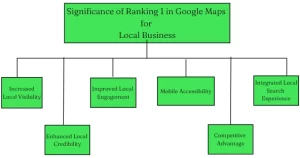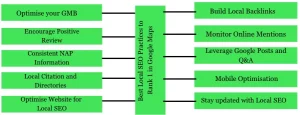Best Local SEO Practices to Rank #1 in Google Maps
SEO on google maps is quite important activity to perform. 46% of Google searches are looking for local information (Source: GoGulf). “Near Me” or “close by” type searches grew by more than 900% over two years (Source: Chat Meter). Local searches result in purchases 28% of the time (Source: Joel Search House Media).
Local SEO refers to conducting internet searches explicitly focusing on finding products, services, or information related to a particular geographical location. This can boost businesses growth helping them capture the market for their products.
When users perform local searches, they are looking for results that are relevant to their immediate vicinity or the area they specify. The blog will take you around SEO for Google Maps, what is it and significance to rank 1 in Google.
Let us read about the local SEO practices to Rank#1 in Google Maps.
Significance of Ranking#1 in Google’s Maps for Local Businesses
Google Maps SEO is significant for businesses that attract local customers and improve online visibility.
Thought it can be stressful to set up Google My Business, but at the same time it is important to set it up.
Some statistics you would know about local SEO:
- 80% of local searches on mobile convert.
- 46% of all Google searches are location-based.
- 86% of all the customers use Google Local Search to find businesses near me.
Let us now read the reasons why Google Maps SEO is crucial
Read: Local SEO for Beginners
Key reasons why Google Maps SEO is crucial:

Increased Local Visibility:
Google Maps SEO helps businesses appear prominently in local search results. When potential customers search for products or services in a specific area, businesses that have optimised their Google Maps presence are more likely to be displayed, increasing their chances of being discovered by local customers.
Enhanced Local Credibility:
A strong presence on Google Maps, including positive reviews and accurate business information, builds credibility and trust among potential customers. Businesses with more positive reviews and ratings are perceived as more reputable and reliable, leading to increased customer confidence and a higher likelihood of conversions.
Improved Local Engagement:
Google Maps SEO provides various opportunities for businesses to engage with their local audience. Responding to customer reviews, addressing inquiries in the Q&A section, and utilising Google Posts are effective ways to interact with customers, strengthen relationships, and showcase excellent customer service.
Mobile Accessibility:
With the growing use of smartphones, Google Maps has become an essential tool for mobile users searching for local businesses. Optimising for Google Maps ensures that businesses are easily accessible to mobile users, increasing the chances of driving foot traffic and generating leads from this significant segment of the market.
Competitive Advantage:
By implementing effective Google Maps SEO strategies, businesses can gain a competitive edge over local competitors. Appearing prominently in Google Maps results, having higher ratings, and providing accurate information help businesses stand out and attract customers who prioritise convenience and reliability.
Integrated Local Search Experience:
Google Maps SEO is closely intertwined with overall local search optimization. Optimising Google My Business and aligning it with other local SEO efforts, such as consistent NAP information and local citations, contribute to a comprehensive and cohesive regional search strategy, improving the overall visibility and attracting more local customers.
Read: Why Ranking on Google Maps is Important for your Local Businesses.?
Benefits Of Google Maps Visibility For Attracting Local Customers
These are the benefits of Google Maps Visibility for attracting local customers
- Increased visibility to potential customers searching for local products or services.
- Higher click-through rates and organic traffic as the top result in Google Maps.
- Improved brand visibility and recognition in the local market.
- Enhanced credibility and trust among consumers as a reputable local business.
- More significant opportunity to attract foot traffic and generate leads.
- Competitive advantage over local competitors in the same industry.
- Easy accessibility for mobile users searching for nearby businesses.
- Positive impact on local SEO rankings and overall online presence.
- Ability to showcase important business information, such as hours of operation, contact details, and customer reviews.
- Opportunity to engage with customers through features like Google Posts and Q&A.
Best Local SEO Practices to Rank#1 in Google Maps
To rank #1 in Google Maps, it’s essential to implement effective local SEO practices. Here are some of the best practices to help you achieve that top spot:

Optimise Your Google My Business (GMB) Profile:
- Claim and verify your GMB listing.
- Provide accurate and complete business information, including NAP details (Name, Address, Phone Number).
- Select relevant and specific categories for your business.
- Add high-quality images and videos showcasing your products, services, and location.
Encourage Positive Reviews:
- Ask satisfied customers to leave reviews on your GMB listing.
- Respond to positive and negative reviews to demonstrate your engagement and commitment to customer satisfaction.
- Monitor and manage your online reputation by addressing customer feedback promptly and professionally.
Consistent NAP Information:
- Ensure your NAP information (Name, Address, Phone Number) is consistent across all online directories, including your website, social media profiles, and local citations.
- Use a consistent format and avoid discrepancies that confuse search engines and potential customers.
Local Citations and Directories:
- List your business on relevant and authoritative local directories, such as Yelp, Yellow Pages, and industry-specific directories.
- Ensure your business information is accurate and consistent across all directories.
- Seek opportunities for high-quality local citations from reputable sources related to your industry.
Optimize Website for Local SEO:
- Include location-based keywords in your website’s meta tags, titles, headings, and content.
- Create location-specific landing pages to target different areas or neighbourhoods.
- Implement schema markup to provide search engines with structured data about your business, such as address, phone number, and business hours.
Build Local Backlinks:
- Seek backlinks from local websites, industry associations, and local influencers.
- Participate in local events, sponsorships, or partnerships that can generate local backlinks.
- Engage with the community by supporting local causes or collaborating with other businesses.
Monitor Online Mentions:
- Monitor online mentions of your business and respond to any mentions or reviews on external websites or social media platforms.
- Engage in local forums or community websites to establish your presence and address inquiries or concerns.
Leverage Google Posts and Q&A:
- Utilise Google Posts to share updates, offers, and events directly on your GMB profile. This can help to keep the audience engaged and updated with the latest.
- Regularly monitor and respond to questions asked by users in the Q&A section of your GMB listing. Responding to questions can increase your engagement.
Mobile Optimization:
- Ensure your website is mobile-friendly and optimised for a seamless user experience on mobile devices.
- Optimise the site for speed, navigation, and usability to cater to mobile users searching for local businesses on their smartphones.
Stay Updated with Local SEO Trends:
- Stay informed about Google’s algorithm updates and adapt your strategies accordingly. Read journals and newsletters published by the industry giants.
- Keep an eye on emerging trends, such as voice search, and optimise your content for voice-based queries.
Conclusion
Implementing the best local SEO practices is essential to rank #1 on Google Maps. By optimising your GMB profile, encouraging positive reviews, maintaining consistent NAP information, building local citations and backlinks, optimising your website, and staying engaged with your audience, you can improve your visibility and attract more local customers.
To further enhance your Google Map SEO strategy and achieve top rankings on Google Maps, contact us at hello[at]noboruworld.com. Our experts can provide specialised SEO services tailored to your business’s needs. Take advantage of the opportunity to dominate the local search landscape and drive more customers to your doorstep.
FAQ
How does Google Maps SEO differ from traditional SEO?
Google Maps SEO focuses specifically on optimising a business’s online presence to improve its visibility and rankings in Google Maps.
Google Places SEO involves optimising the Google My Business profile, managing reviews, building local citations, and ensuring consistent NAP information. Traditional SEO, on the other hand, focuses on optimising a website to rank higher in organic search results.
Does Google Maps SEO impact organic search rankings?
While Google Maps SEO and organic search rankings are separate, they can influence each other. A strong presence on Google Maps, including positive reviews and accurate information, can improve a business’s online reputation and credibility, which may indirectly impact organic search rankings. Additionally, local signals from Google Maps can influence local pack rankings in organic search results.
What are some key factors to consider for SEO for Google Maps?
Critical factors for Google Maps SEO include optimising the Google My Business profile, obtaining positive reviews, ensuring consistent NAP information across directories, building local citations, and optimising the website for local SEO.
Other factors include user engagement with the Google Maps listing, mobile-friendliness, local backlinks, and relevance of business categories and attributes. Regular monitoring and staying updated with Google’s algorithm changes are also crucial for effective Google Maps SEO.
What is the Google Map 3-Pack?
The Google Map 3-Pack, also known as the Local 3-Pack or simply the 3-Pack, is a prominent and obvious feature in Google’s search results. It consists of three business listings displayed at the top of the search results page when users perform location-based searches. These listings are usually accompanied by a map highlighting the businesses’ locations.
How does the Google Map 3-Pack work?
When a user enters a local search query, such as “coffee shops near me” or “dentists in [city],” Google’s algorithms identify the user’s location or the specified location in the query and display three relevant local businesses that match the search criteria. These businesses are typically displayed with their names, addresses, phone numbers, and a link to their Google My Business (GMB) profiles.
Why is the Google Map 3-Pack important for businesses?
The 3-Pack is highly coveted by businesses because it offers significant visibility to users looking for local products or services. Being featured in the 3-Pack can drive organic traffic, increase brand visibility, and attract potential customers. It’s a valuable asset for local businesses to gain a competitive edge in their respective markets.
How can a business get listed in the Google Map 3-Pack?
To increase the chances of appearing in the 3-Pack, businesses should optimise their online presence, especially their Google My Business profiles. Factors that influence inclusion in the 3-Pack include the relevance of the business to the search query, proximity to the user’s location, and the quality and consistency of the business’s online information, including reviews and ratings.
Is the Google Map 3-Pack important for mobile and voice searches?
The 3-Pack is essential for mobile and voice search users. It’s often the first thing users see or hear when searching for local businesses on mobile devices or through voice assistants. Therefore, having an optimised online presence and Google My Business profile is crucial for businesses targeting these types of searches.



